
×
![Buchcover ISBN 9783832544928]()
Design, Modeling and Control of Aerial Robots for Physical Interaction and Manipulation
von Burak YükselAerial robots, meaning robots with flying capabilities, are essentially robotic platforms, which are autonomously controlled via some sophisticated control engineering tools. Similar to aerial vehichles, they can overcome the gravitational forces thanks to their design and/or actuation type. What makes them different from the conventional aerial vehicles, is the level of their autonomy. Reducing the complexity for piloting of such robots/vehicles provide the human operator more freedom and comfort. With their increasing autonomy, they can perform many complicated tasks by their own (such as surveillance, monitoring, or inspection), leaving the human operator the most high-level decisions to be made, if necessary. In this way they can be operated in hazardous and challenging environments, which might posses high risks to the human health. Thanks to their wide range of usage, the ongoing researches on aerial robots is expected to have an increasing impact on the human life.
Aerial Physical Interaction (APhI) is a case, in which the aerial robot exerts meaningful forces and torques (wrench) to its environment while preserving its stable flight. In this case, the robot does not try avoiding every obstacle in its environment, but prepare itself for embracing the effect of a physical interaction, furthermore turn this interaction into some meaningful robotic tasks. Aerial manipulation can be considered as a subset of APhI, where the flying robot is designed and controlled in purpose of manipulating its environment. A clear motivation of using aerial robots for physical interaction, is to benefit their great workspace and agility. Moreover, developing robots that can perform not only APhI but also aerial manipulation can bring the great workspace of the flying robots together with the vast dexterity of the manipulating arms.
This thesis work is addressing the design, modeling and control problem of these aerial robots for the purpose of physical interaction and manipulation. Using the nonlinear mathematical models of the robots at hand, in this thesis several different control methods (IDA-PBC, Exact Linearization, Differential Flatness Based Control) for APhI and aerial manipulation tasks have been developed and proposed. Furthermore, novel design tools (e. g. new rigid/elastic manipulating arms, hardware, software) to be used together with miniature aerial robots are presented within this thesis, which contributes to the robotics society not only in terms of concrete theory but also practical implementation and experimental robotics.
Aerial Physical Interaction (APhI) is a case, in which the aerial robot exerts meaningful forces and torques (wrench) to its environment while preserving its stable flight. In this case, the robot does not try avoiding every obstacle in its environment, but prepare itself for embracing the effect of a physical interaction, furthermore turn this interaction into some meaningful robotic tasks. Aerial manipulation can be considered as a subset of APhI, where the flying robot is designed and controlled in purpose of manipulating its environment. A clear motivation of using aerial robots for physical interaction, is to benefit their great workspace and agility. Moreover, developing robots that can perform not only APhI but also aerial manipulation can bring the great workspace of the flying robots together with the vast dexterity of the manipulating arms.
This thesis work is addressing the design, modeling and control problem of these aerial robots for the purpose of physical interaction and manipulation. Using the nonlinear mathematical models of the robots at hand, in this thesis several different control methods (IDA-PBC, Exact Linearization, Differential Flatness Based Control) for APhI and aerial manipulation tasks have been developed and proposed. Furthermore, novel design tools (e. g. new rigid/elastic manipulating arms, hardware, software) to be used together with miniature aerial robots are presented within this thesis, which contributes to the robotics society not only in terms of concrete theory but also practical implementation and experimental robotics.


